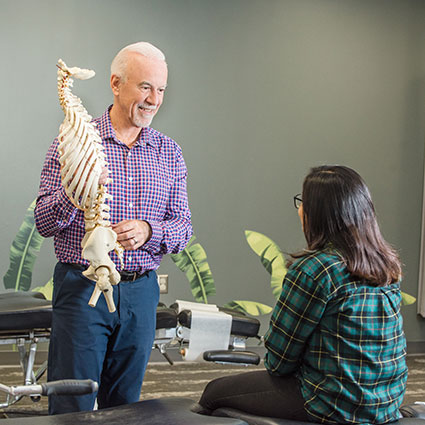Disc Injuries
 The discs of the spine function both as a shock absorber and a spacer (to separate the bones of the spine, thereby allowing more space for the spinal nerves to exit from the spinal cord without being “pinched”). The disc is like a thick-walled water balloon that is squeezed down between two vertebra (bones of the spine). The “thick wall” is cartilage and the “water” inside is a thick fluid with the consistency of Vaseline or Crisco.
The discs of the spine function both as a shock absorber and a spacer (to separate the bones of the spine, thereby allowing more space for the spinal nerves to exit from the spinal cord without being “pinched”). The disc is like a thick-walled water balloon that is squeezed down between two vertebra (bones of the spine). The “thick wall” is cartilage and the “water” inside is a thick fluid with the consistency of Vaseline or Crisco.
The disc can be damaged through a major trauma (like lifting something that is very heavy) or by repetitive micro-trauma over a period of time (for example, long periods of sitting, driving, repeated bending or twisting). The result of these traumas can be that the disc will thin out/degenerate, bulge, or herniate. Which result occurs is determined by age, health, weight and/or severity and frequency of trauma along with other factors.
The cartilage of the outer walls of the disc are damaged or weakened to varying degrees due to trauma. As pressure is put onto a disc, the inner material of the disc (nucleus pulposis) is pushed outward. If the cartilage wall that is trying to hold in this nucleus pulposis has been weakened, then the nucleus pulposis can:
- Slowly leak past the damaged cartilage fibers (like air slowly leaking out of a tire). The amount of material that leaks out will determine the remaining thickness of the disc. The thinner the disc (thinning disc/disc degeneration) the less shock absorption and the less space for the spinal nerves to exit from the spinal cord, causing a greater likelihood of the nerve being “pinched”.
- Push out the cartilaginous wall of the disc causing a bulging disc (like a bubble in a tire). This bulging disc can put pressure against the spinal cord or can take up space that the spinal nerves need to exit from the spinal cord, causing a greater likelihood of the nerve being “pinched”.
- Or suddenly have a large volume of material push (herniate) through the cartilaginous wall causing a herniated disc. The herniated material can lodge against the spinal cord, the nerve root or reduce the space the nerve has to exit from the spinal cord, causing a greater likelihood of the nerve being “pinched”.
Intermittant traction is a recommended treatment for any of these conditions. Intermittant traction is a safe, gentle, effective, conservative treatment which creates a negative pressure in the disc which helps to “suck” the nucleus pulposis back within the confines of the disc’s cartilaginous wall.
Treatment using this technique is usually provided over the course of 4-6 weeks.
Feel Your Best
Schedule an appointment today. Call our Fairfax chiropractic office!
CONTACT US »
